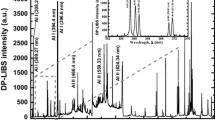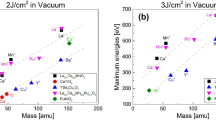Abstract
The current study is dedicated to investigating the electron dynamics of the breakdown and plasma generation in molecular oxygen at a pressure extended from 4.6 to 75 kPa. The breakdown is motivated by far-infrared laser source operational at λ = 10.591 µm, (hν ~ 0.12 eV) with pulse width 2τ = 64 ns (FWHM) (Camacho et al. in J Phys D Appl Phys 41(10):105201, 2008). This experiment presumed the presence of a new electron ignition mechanism to produce a specific density of seed electrons in the interaction region as a substitution of the negligible involvement of the photoionization process. The analysis is grounded on adapting the electron cascade model given in our past paper (Evans and Gamal in J Phys D Appl Phys 13(8):1447, 1980). This model well thought out the determination of the threshold intensity as a function of gas pressure taken into account the possible physical processes which may take place in the interaction volume. In doing so, the governing differential equation that defines the variation of the energy of electrons during the laser pulse is solved numerically together with a set of rate equations presenting the change of population of the excited states. The calculated breakdown threshold intensity showed a reasonable agreement with the measured ones, where both indicated weak dependence over the tested pressure range. This behavior is resolved by studying the individual effect of each loss processes involved in the model on the threshold intensity concerning the experimentally assumed density of the initial electrons corresponding to the tested gas pressure range. Besides, to evaluate the precise involvement of the action of the single loss process to the mechanism responsible for plasma production, computations of the temporal variation of the density of electrons are carried out in the presence and absence of the individual loss process.










Similar content being viewed by others
References
Camacho, J.J.; Dıaz, L.; Santos, M.; Reyman, D.; Poyato, J.M.L.: Optical emission spectroscopy of oxygen plasma induced by IR CO2 pulsed laser. J. Phys. D Appl. Phys. 41(10), 105201 (2008)
Evans, C.; Gamal, Y.-D.: Laser-induced breakdown of helium. J. Phys. D Appl. Phys. 13(8), 1447 (1980)
Zeldovich, Y.B.; Raizer, P.: Cascade ionization of a gas by a light pulse. Zh. Eksperim. i. Teor. Fiz. 47 (1964)
Askaryan, G.; Rabinovich, M.: Cascade ionization of a medium under the action of an intense light flash. Zh. Eksperim. I Teor. Fiz. 48 (1965)
Chan, C.H.; Moody, C.D.: Solutions of the classical Boltzmann equation for He and Ne gas breakdown. J. Appl. Phys. 45, 1105–1111 (1974). https://doi.org/10.1063/1.1663375.
Nielsen, P.; Canavan, G.: Electron cascade theory in laser-induced breakdown of preionized gases. J. Appl. Phys. 44(9), 4224–4225 (1973)
Louis-Jacquet, M.; Decoster, A.: Theoretical study of the laser-induced electron cascade in a gas. J. Phys. B: At. Mol. Phys. 10(2), 197 (1977)
Gamal, Y.E.-D.; Omar, M.: Study of the electron kinetic processes in laser-induced breakdown of electronegative gases over an extended wavelength range. Radiat. Phys. Chem. 62(5–6), 361–370 (2001)
Chan, C.; Moody, C.; McKnight, W.: Significant loss mechanisms in gas breakdown at 10.6 μ. J. Appl. Phys. 44(3), 1179–1188 (1973)
Stricker; Parker, J.G.: Experimental investigation of electrical breakdown in nitrogen and oxygen induced by focused laser radiation at 1064 μ. J. Appl. Phys. 53, 851 (1982). https://doi.org/10.1063/1.330592.
Phuoc, T.X.: Laser spark ignition: experimental determination of laser-induced breakdown thresholds of combustion gases. Opt. Commun. 175(4–6), 419–423 (2000)
Khan, N.; Mariun, N.; Aris, I.; Yeak, J.: Laser-triggered lightning discharge. New J. Phys. 4, 61.1–61.20 (2002)
Camacho, J.J.; Poyato, J.M.L.; Diaz, L.; Santos, M.: Optical emission studies of nitrogen plasma generated by IR CO2 laser pulses. J. Phys. B: At. Mol. Opt. Phys. 40(24), 4573–4590 (2007). https://doi.org/10.1088/0953-4075/40/24/003.
Generalonv, A.; Zimakovv, P.; Kozlov, I.; Masyicovv, A.; Raizer, Y.P.: Sov. Phys. JETP Lett. 11, 222 (1970)
Berger, P.J.; Smith, D.C.: Gas breakdown in the laser as the limitation of pulsed high-pressure CO2 lasers. Appl. Phys. Lett. 21(4), 167–170 (1973)
Hull, R.J.; Lencioni, D.E.; Marquet, C.: Laser Interaction and Related Plasma Phenomena Vol 11. Schwarz, H.J.; Hora, H. (eds.) Plenum, New York (1972)
Lowder, J.E.; Lencioni, D.E.; Hilton, T.W.; Hull, R.J.: High energy pulsed CO2 laser-target interactions in air. J. Appl. Phys. 44(6), 2759–2762 (1973). https://doi.org/10.1063/1.1662646.
Lencioni, D.E.: The effect of dust on 10.6-μm laser-induced air breakdown. Appl. Phys. Lett. 23, 12 (1973). https://doi.org/10.1063/1.1654718.
Morgan, F.: AWRE Report No. SPA2 N 20174 (1974).
Brown, R.T.; Smith, D.C.: Laser-induced gas breakdown in the presence of preionization. Appl. Phys. Lett. 22(5), 245–247, 1973
Bass, M.; Barrett, H.H.: Laser-induced damage probability at 1.06 μm and 0.69 μm. Appl. Opt. 12(4), 690–699 (1973)
Smith, D.: Laser-induced gas breakdown and plasma interaction. In: 38th Aerospace Sciences Meeting and Exhibit (2000)
Camacho, J.J.; Santos, M.; Diaz, L.; Poyato, J.M.L.: Optical emission spectroscopic study of plasma plumes generated by IR CO2 pulsed laser on carbon targets. J. Phys. D: Appl. Phys. 41, 215206–215213 (2008)
Camacho, J.J.; Diaz, L.; Santos, M.; Juan, L.J.; Poyato, J.M.L.: In laser beams: theory, properties and applications. In: Thys, M., Desmet, E. (eds.) Optical Breakdown in Gases induced by High-Power IR CO2 Laser Pulses. Nova Science Publishers, New York (2009)
Camacho, J.J.; Santos, M.; Diaz, L.; Juan, L.J.; Poyato, J.M.L.: Spectroscopy study of air plasma induced by IR CO2 laser pulses. Appl. Phys. A. 99, 159–175, 2010
Diaz, L.; Camacho, J.J.; Cid, J.P.; Martin, M.; Poyato, J.M.L.: Time evolution of the infrared laser ablation plasma plume of SiO. Appl. Phys. A. 117(1), 125–129 (2014)
Camacho, J.J.; Diaz, L.; Martinez-Ramirez, S.; Caceres, J.O.: Time- and space- resolved spectroscopic characterization of laser-induced Swine muscle tissue plasma. Spectrochim. Acta B. 111, 92–101 (2015)
Gamal, Y.E.E.-D.; Nassef, O.; Salama, A.: On the role of the preionization mechanism in the optical breakdown of molecular oxygen induced by CO2 laser: numerical investigation. Phys. Plasma 26, 062116 (2019). https://doi.org/10.1063/1.5092434.
Phelps, A.V.: JILA information Center Report, NO. 28, University of Colorado, Sept. 1. (1985)
Kroll, N.; Watson, K.M.: Theoretical study of ionization of air by intense laser pulses. Phys. Rev. A 5, 1883–1905 (1972}
Itikawa, Y.; Ichimura, A.; Onda, K.; Sakimoto, K.; Takayanagi, K.; Hatano, Y.; Hayashi, M.; Nishimura, H.; Tsurubuchi, S.: Cross sections for collisions of electrons and photons with oxygen molecules. J. Phys. Chem. Ref. Data 18, 23 (1989) (designated as JPCRD89)
Heald, M.A.; Wharton, C.B.: Plasma Diagnostics with Microwaves. Wiley, New York (1965)
Itikawa, Y.: Cross sections for electron collisions with oxygen molecules. J. Phys. Chem. Ref. Data 38, 1–21 (2009)
Jeon, B.H.: Determination of electron collision cross-sections for the oxygen molecule by using an electron swarm study. J. Korean Phys. Soc. 43, 513–525 (2003)
Author information
Authors and Affiliations
Corresponding author
Rights and permissions
About this article
Cite this article
Gamal, Y.E.ED., Elsayed, K.A. & Nassef, O.A. Study of Electron Dynamics Controlling the Threshold Intensity Dependence on the Gas Pressure in FIR Laser-Induced Breakdown of Molecular Oxygen: Effect of Loss Processes. Arab J Sci Eng 46, 5875–5884 (2021). https://doi.org/10.1007/s13369-020-05077-2
Received:
Accepted:
Published:
Issue Date:
DOI: https://doi.org/10.1007/s13369-020-05077-2




